Revving Up Green Machines
Researchers are looking into new ways to make cars run more efficiently with less impact on the environment.
By Emily Sohn
People love their “zoom, zoom.” In the United States alone, 17 million new cars hit the road in 2004.
But the freedom to travel anywhere, anytime in a car or truck comes at a price. And it’s not just the cost of gasoline, insurance, and repairs. Automobiles are a major source of pollution. Most cars burn gasoline, which releases carbon dioxide gas into the air, along with other particles and pollutants.
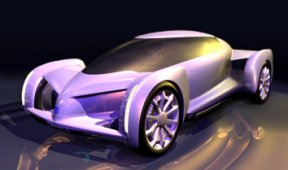 |
|
The futuristic AUTOnomy vehicle was designed by General Motors to show what a car built around a fuel cell propulsion system might be like. |
| General Motors |
To help counter soaring gas prices and reduce air pollution, researchers are looking into new ways to make cars run more efficiently with less impact on the environment.
Some environmentally friendly “green” cars already on the street use a mixture of gas and electricity. When such a hybrid vehicle stops, its gas engine shuts down and an electric motor powered by batteries takes over. When the car speeds up, the engine starts, moving the car and recharging the batteries. At high speeds, the gas engine and electric motor operate together.
More futuristic technologies involve the use of hydrogen as a fuel. Some companies have already built vehicles that run on hydrogen, but many obstacles remain before you’ll see a lot of hydrogen-powered cars on the road and hydrogen filling stations where you can refuel.
Hydrogen power
Getting energy out of hydrogen to power a car involves a device called a fuel cell.
A molecule of hydrogen consists of two hydrogen atoms. In a typical fuel cell, a metal such as platinum splits up hydrogen molecules. The process releases electrons, which generate an electric current that can be used to run a motor. The hydrogen atoms, which have each lost an electron, combine with oxygen from the air in another part of the fuel cell. When two hydrogen atoms combine with one oxygen atom, the result is a molecule of water (H2O).
So, the only “waste” product is water. That’s pretty clean!
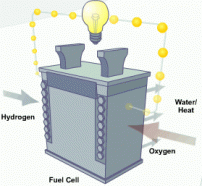 |
|
In a fuel cell, hydrogen combines with oxygen to produce water and release energy. |
| U.S. Department of Energy |
Hydrogen is an appealing carrier of energy, says Nathan Glasgow. He’s a consultant at the Rocky Mountain Institute in Snowmass, Colo. The element is light, stable, and highly abundant, he says.
Getting a good supply of hydrogen, however, is harder than you might think. The problem is that most hydrogen on Earth is attached to something else, mainly carbon or oxygen.
It takes a lot of energy to break apart water and other molecules to get the hydrogen out. This energy usually comes from burning oil or coal, which produces lots of carbon dioxide and other pollutants.
It might be better, for example, to use wind power instead of coal or oil to provide the energy to split water. However, the windiest places, such as North Dakota, are far from where most people live. So, the hydrogen would need to be stored and shipped.
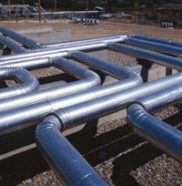 |
|
Hydrogen can be transported by pipeline or delivered by trucks. |
| U.S. Department of Energy |
Right now, there’s no system of pipes for transporting hydrogen. And that’s a major problem, Glasgow says. “We have to find a way to move it around.”
Run times
Another challenge is getting enough juice from hydrogen to keep a car running for a long time. Right now, a tank of hydrogen can propel a car only about 100 or 150 miles. That means refueling a lot more often than most people would like.
Today’s fuel cells are also expensive. A fuel-cell-powered car might cost more than 10 times as much as a gas-powered car would cost.
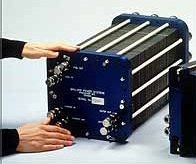 |
|
Today’s fuel cells are bulky, heavy, and expensive. |
| U.S. Department of Energy |
And fuel cells wear out faster than gas engines. Typical fuel cells for cars have an operating lifetime of about 1,000 hours of driving time. A gas engine lasts at least 5,000 hours, spread over more than 10 years.
Nonetheless, the U.S. government has pledged more than $1 billion toward the effort to improve hydrogen fuel cell technology. Three states—California, Florida, and New York—plan to spend millions in the next 5 years to test electric cars powered by hydrogen and build a network of hydrogen filling stations. A hydrogen pump opened earlier this year in Washington, D.C.
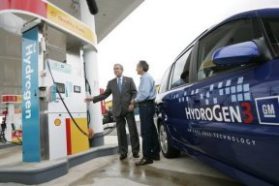 |
|
President Bush visited a Washington, D.C., gas station where hydrogen is also available. |
| White House photo by Paul Morse |
There’s a long way to go. “We don’t think mobile fuel cells are going to come on-line for another 20 years,” Glasgow says.
New materials
In the meantime, scientists and environmentalists are pushing other strategies for making cars that are less harmful to the environment. The Rocky Mountain Institute, for instance, supports a move toward lighter automobiles.
The lighter a car, Glasgow says, the less energy (and fuel) that it takes to move it.
Think about how much harder it is to walk up stairs with a heavy load. “If your backpack itself weighs 50 pounds, and then you start putting books in, it doesn’t make any sense,” Glasgow says.
Heavy cars are just as inefficient. “You want to move people and cargo,” he says. “There’s no value added in moving a large, heavy car, too.”
To make cars lighter and cheaper while keeping their size and strength, Glasgow says, companies are trying out new materials. Extra-light steel, ceramics, aluminum with titanium or magnesium, and other materials borrowed from the aerospace industry are a few examples.
One company is now putting lightweight carbon fibers into some of its cars’ roofs and hoods to lighten the load.
Making automobiles lighter would also be a huge step toward making fuel cells practical when they become cheaper and more readily available, Glasgow says.
Future travel
For now, hybrid cars that save fuel by running partly on electricity are becoming increasingly popular. So is the use of alternative fuels, such as natural gas and biodiesel, which can come from vegetable oil, animal fat, or recycled restaurant grease.
 |
|
A hybrid vehicle like the one shown has both an electric motor and a gas-powered engine. |
| U.S. Department of Energy |
There might be even more options available by the time you get your learner’s permit, if you haven’t started driving already. And, in another generation or so, you could be zooming around in a hydrogen-fueled car.
Going Deeper:







